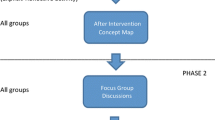Abstract
The application of constructivist referents for teaching science has received some recent unwarranted criticism. To counter some of the pedagogical criticisms, the teacher's role and actions within a Year 6 science classroom learning community are described. In particular, my interpretation of two teaching episodes shows how the teacher helped a group of students transform their understanding of electrical circuits. The teacher in this study mediated learning by monitoring the transformation of student understanding and negotiating scientific practices—teaching practices which need to be illustrated more fully by researchers to avoid further confusion about the application of idea-based social constructivism. I argue that the teacher's role, from a social constructivist perspective, is to employ whatever strategies are needed to help students develop a deeper understanding of canonical science.
Similar content being viewed by others
References
Australian Academy of Science. (1994).Primary investigations: Student book 6—Energy and investigation. Canberra: Australian Academy of Science.
Bain, J. (1994, September).Understanding by learning or learning by understanding: How shall we teach? An inaugural lecture by the Professor of Teaching and Learning, Faculty of Education, Griffith University, Brisbane.
Biddulph, F., & Osborne, R. (Eds.). (1984).Making sense of our world: An interactive teaching approach. Hamilton, NZ: University of Waikato.
Cobb, P., Yackel, E., & Wood, T. (1992). A constructivist alternative to the representational view of mind in mathematics education.Journal of Research in Mathematics Education, 23 2–33.
Cosgrove, M. (1995). A study of science-in-the-making as students generate an analogy for electricity.International Journal of Science Education, 17 (3), 295–310.
Glasersfeld, E. von (1995).Radical constructivism: A way of knowing and learning. London: The Falmer Press.
Guba, E., & Lincoln, Y. S. (1989).Fourth generation evaluation. Beverly Hills, CA: Sage.
Fensham, P. J., Gunstone, R. F., & White, R. T. (Eds.), (1994).The content of science: A constructivist approach to its teaching and learning. London: The Falmer Press.
Johnson, P., & Gott, R. (1996). Constructivism and evidence from children's ideas.Science Education, 80 (5), 561–577.
Jordon, B., & Henderson, A. (1995). Interaction analysis: Foundations and practice.The Journal of the Learning Sciences, 4 (1), 39–103.
Kaufman, D. R., Patel, V. L., & Magder, S. A. (1996). The explanatory role of spontaneously generated analogies in reasoning about physiological concepts.International Journal of Science Education, 18 (3), 369–386.
Osborne, J. F. (1996). Bevond constructivism.Science Education, 80 (1), 53–82.
Prawat, R. S. (1993). The value of ideas: Problems versus possiblities in learning.Educational Researcher, 22 (6), 5–16.
Prawat, R. S. (1996). Learning community, commitment and school reform.Journal of Curriculum Studies, 28 (1), 91–110.
Ritchie, S. M. (1994). Metaphor as a tool for constructivist science teaching.International Journal of Science Education, 16 (3), 293–303.
Ritchie, S. M. (1997, July).The discursive power of student-generated analogies: A primary science teacher's dilemma. Paper presented at the annual conference of the Australasian Science Education Research Association, Adelaide, Australia.
Ritchie, S. M., & Rigano, D. L. (1996). Laboratory apprenticeship through a student research project.Journal of Research in Science Teaching, 33 (7), 799–815.
Ritchie, S. M., Tobin, K., & Hook, K. (1997). Teaching referents and the warrants used to test the viability of students' mental models: is there a link?Journal of Research in Science Teaching, 34 (3), 223–236.
Roth, W.-M. (1995).Authentic school science: Knowing and learning in open-inquiry science laboratories, Dordrecht: Kluwer Academic Publishers.
Roth, W.-M., McRobbie, C. J., Lucas, K. B., & Boutonné, S. (1997). Why may students fail to learn from demonstrations? A social practice perspective on learning in physics.Journal of Research in Science Teaching, 34 (5), 509–533.
Roth, W.-M., & Tobin, K. (1996). Staging Aristotle and natural observation against Galileo and (stacked) scientific experiment or physics lectures as rhetorical events.Journal of Research in Science Teaching, 33 (2), 135–157.
Tobin, K., Roth, W.-M., & Brush, S. (1995). Teaching physics to prospective elementary teachers: Bridging gaps or widening chasms.Research in Science Education, 25 (3), 267–281.
Tobin, K., & Tippins, D. (1993). Constructivism as a referent for teaching. In K. Tobin (Ed.),The practice of constructivism in science education (pp. 3–22). Hillsdale, NJ: Lawrence Erlbaum.
Tobin, K., & Tippins, D. J. (1996). Metaphors as seeds for conceptual change and the improvement of science teaching.Science Education, 80 (6), 711–730.
Tobin, K., Tippins, & Hook, K. S. (1994). Referents for changing a science curriculum: A case study of one teacher's change in beliefs.Science & Education, 3, 245–264.
White, R., & Gunstone, R. (1992).Probing understanding. London: The Falmer Press.
Author information
Authors and Affiliations
Corresponding author
Rights and permissions
About this article
Cite this article
Ritchie, S.M. The teacher's role in the transformation of students' understanding. Research in Science Education 28, 169–185 (1998). https://doi.org/10.1007/BF02462903
Issue Date:
DOI: https://doi.org/10.1007/BF02462903




